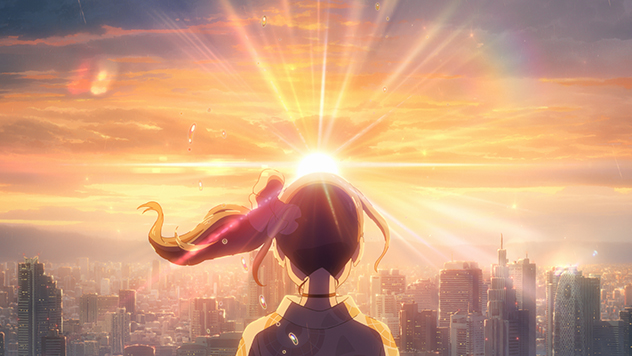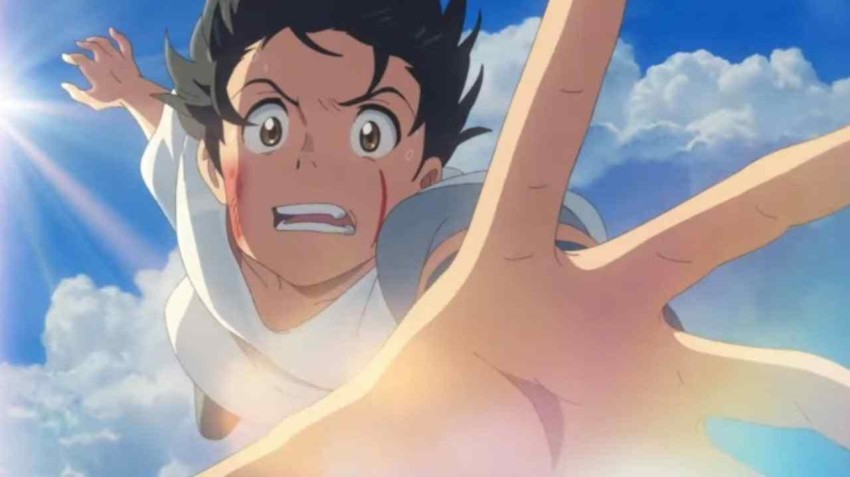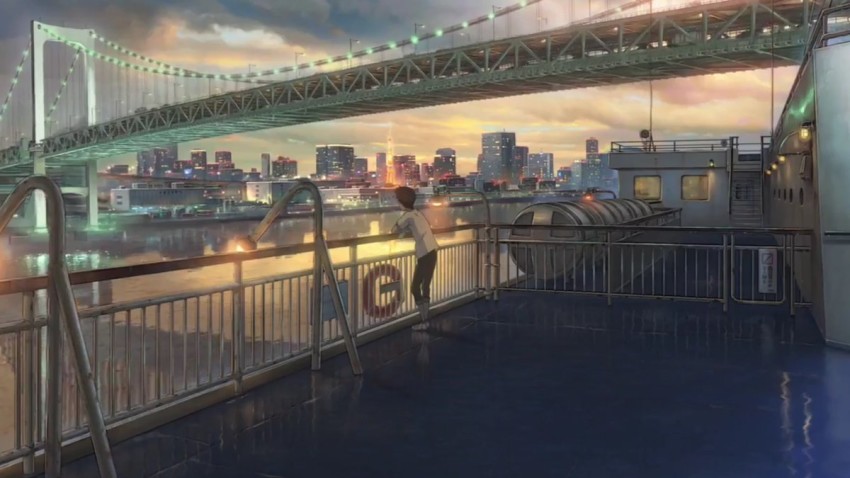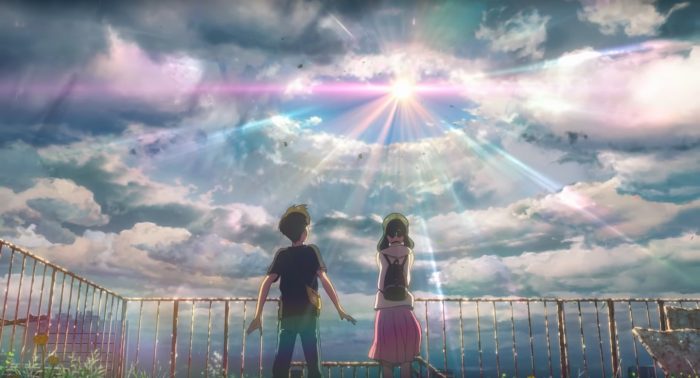Shinkai on Weathering
January 6, 2020 · 0 comments
By Andrew Osmond.
It’s been three years since Makoto Shinkai was last in London. “I don’t remember it being this dark or this cold,” he says. A moment later, he confirms that his new film, Weathering with You, is chiefly inspired by the climate crisis. “I don’t know how things are here in London, but in Japan we’re getting heavier and heavier rain every summer, and we’re clearly getting more flooding. This climate crisis that we’ve been hearing about for a while is now a reality. We’re actually experiencing it and the world is out of control.”
Shinkai isn’t reticent about his motives in making his films. The last time he was here, he was as upfront about Your Name being his response to the Tohoku tsunami of 2011. He’s speaking about Weathering at London’s BFI Southbank, which he first visited so long ago that it was called the National Film Theatre back then. “The first time I came here was 15 years ago and the film back then was Voices of a Distant Star, which I animated myself by hand. But with Weathering with You, there were more than five hundred people working on the animation, so it’s hard for me to keep track of who did what exactly. It just reminds me of how much things have changed in the last 15 years.”
The director looked extremely young back then. I saw him at the NFT with a Japanese friend who took one look at the baby-faced, glasses-wearing auteur and whispered, “Nobita.” Now Shinkai looks slightly more mature, but still with an extreme diffidence. He prefaces his first answer by thanking the audience for turning up. “I always feel very nervous speaking in front of an audience who’ve just watched one of my films. I don’t really get a sense of whether people enjoyed it or not, just looking at their faces.” We reassure him with a round of applause.
Still, Shinkai has a more impish humour these days, reflected in increasingly funny films – like Your Name, Weathering With You is no comedy, but has a great many comedic moments. It also shows when he’s asked if he felt the pressure of following up Your Name. “I didn’t really feel that kind of pressure because my job as a director is to make the best film possible. Making that film a hit is the job of the producers and the distributors, so if it doesn’t sell, then that’s their fault.” It gets the biggest laugh of the evening.
 Shinkai’s no haughty artist. He calls Weathering “a piece of entertainment from the start” and says his main responsibility is to give the audience what they want. “I wanted this film to be accessible to as many people as possible, and particularly to people who might not normally go to the cinema.” It was for that reason, Shinkai says, that he went for a story based in real life, but still with a supernatural side, as his heroine Hina glimpses an otherworld in the clouds, then gains the power to bring sunshine to the wettest day.
Shinkai’s no haughty artist. He calls Weathering “a piece of entertainment from the start” and says his main responsibility is to give the audience what they want. “I wanted this film to be accessible to as many people as possible, and particularly to people who might not normally go to the cinema.” It was for that reason, Shinkai says, that he went for a story based in real life, but still with a supernatural side, as his heroine Hina glimpses an otherworld in the clouds, then gains the power to bring sunshine to the wettest day.
Weathering also has a subplot about a Japanese magazine like Britain’s Fortean Times, which investigates phenomena shunned by respectable science. “Even people living in modern cities like Tokyo or London, we all have some kind of magic that we believe in,” Shinkai says. “For example, when I lived in London, I was so surprised to see everyone on the tube reading the Metro newspaper, reading the horoscope page. It’s the same in Japan. We go to the shrine and pray, and I think everyone has a way in their everyday life of expressing their wishes like that.”
Shinkai may want his films to have universal appeal, but he knows the value of (wholesome) fanservice. Weathering has cameos by both of Your Name’s lead characters, Taki and Mitsuha. Although there was a comparable cameo in Your Name (a character from Garden of Words), Shinkai says Weathering’s cameos came from fan demand.
 “Your Name was so popular, and a lot of the fans were saying, please can we see Taki and Mitsuha just a little bit in your next film, especially the fans in Korea and China. I just thought that if everyone wanted it, why not? So when you see Taki and Mitsuha in Weathering, it’s just before they have their re-encounter on the staircase (in Your Name). I wanted to show that, even though they haven’t had that second encounter with their destiny yet, they’re still going about their daily lives, they’ve still got their jobs, they’re still laughing with their friends.”
“Your Name was so popular, and a lot of the fans were saying, please can we see Taki and Mitsuha just a little bit in your next film, especially the fans in Korea and China. I just thought that if everyone wanted it, why not? So when you see Taki and Mitsuha in Weathering, it’s just before they have their re-encounter on the staircase (in Your Name). I wanted to show that, even though they haven’t had that second encounter with their destiny yet, they’re still going about their daily lives, they’ve still got their jobs, they’re still laughing with their friends.”
Shinkai confirms he didn’t work on any of Weathering’s animation. Indeed, the technical complexity of merging trad animation with CGI left him behind, especially in the countless shots of rain. With some of the animation, he says, “I don’t even know which techniques the animators used for which parts.” Instead, Shinkai said, he left the animation to Ghibli veteran Atsushi Tamura, who was Weathering’s Animation Director, while Shinkai focused on the story.
He wrote the script first, over six months, followed by the storyboard over another ten. “I drew the designs on which the animation was based; how long each scene should be (and) how a character should walk.” Shinkai doesn’t miss his Voices one-man-band days, handling the animation and everything else. “My interests have changed. Back then I did everything myself because I think I was trying to figure out what I was good at. But now my most important job, I think, is working out what the audience want from a film, and so I do the scriptwriting and storyboards… That’s the most important job now.”
Like Your Name, Weathering with You is scored by the pop band Radwimps, with whom Shinkai worked closely. “I gave Radwimps the first draft of the (Weathering) script and they wrote me a few pieces based on that,” Shinkai says. “And then I listened to those songs as I was creating the storyboards, and sometimes I would ask them to change the songs a bit in line with how I wanted the story to work… and sometimes they would give me advice on the characters; maybe the character should say this line a bit differently so it fits in better with the song. And they’d give me their opinion on the actual story. That process went on for ten months.”
 As with Your Name, the film’s novelisation by Shinkai was another part of the creative process. “To be honest, I never really want to write the novel. I’m too busy working on the film, I think I can’t possibly have time to write the book as well. But when I actually get into it, I find that it’s quite fun, especially in this case because I was writing in the first person as the character. That leads to a lot of discoveries, and some of those discoveries were useful when it came to directing the voice actors.” The Weathering book was published in tandem with the film in Japan. For all his earlier modesty, Shinkai can’t resist mentioning it was Japan’s bestselling novel of 2019.
As with Your Name, the film’s novelisation by Shinkai was another part of the creative process. “To be honest, I never really want to write the novel. I’m too busy working on the film, I think I can’t possibly have time to write the book as well. But when I actually get into it, I find that it’s quite fun, especially in this case because I was writing in the first person as the character. That leads to a lot of discoveries, and some of those discoveries were useful when it came to directing the voice actors.” The Weathering book was published in tandem with the film in Japan. For all his earlier modesty, Shinkai can’t resist mentioning it was Japan’s bestselling novel of 2019.
Today, Shinkai’s work is adapted by other hands. A stage version of Garden of Words will run in London this coming July and August. Far more contentiously, an American remake of Your Name is being produced by J.J. Abrams; reports last year said it would be directed by Marc Webb (500 Days of Summer, Amazing Spider-Man) and would transpose the story to America.
“It’s true,” Shinkai says (in English, as if to reinforce the answer). “Bad Robot Productions are already working on it. I visited them fairly recently, in fact. Abrams was working very hard on Star Wars. It was about two months ago and he was saying, I can’t believe that we’re doing a simultaneous release around the world in just two months’ time. That was quite reassuring for me because I thought, We’re all the same… They’re talented people and I’m looking forward to seeing what they do with it, and how it turns out as a live-action film. I don’t know if it’ll go well or not, but I am interested to see the outcome.”
A big difference between Your Name and Weathering is their young leads. In Weathering, they’re no longer just average Japanese kids; they can be dangerous, even menaces to society. Hodaka, the runaway boy lead, points loaded guns at adults. Hina, the girl, brings down lightning with devastating force. “Hodaka has his own sense of justice, and his sense of justice is to save Hina,” Shinkai says. “But in pursuing his own justice, he collides with society’s sense of justice and with the police in order to do that. I wanted to show this young boy gradually dropping out of society; I thought that might resonate with a young audience.” Even at the start, we see Hodaka is reading the quintessential teen rebel text, Catcher in the Rye.
“To do that, I had to show the darker side of Tokyo,” Shinkai adds. The early scenes set Hodaka adrift in the violence and sexploitation of Kabukicho, a seedy district in the shadow of Shinjuku station. For Shinkai, Weathering is the story of Hodaka getting to know the confusing city. “At the same time as Hodaka’s getting to know Hina, he’s getting to know Tokyo.” This comes from Shinkai’s experience. “I’ve been living in Tokyo now for twenty years, but I still remember that surprise, that wonder that I felt when I first came from the Japanese countryside to Tokyo.”
Yet Shinkai feels Tokyo’s days are numbered. You might remember a line near the end of Your Name, after the obliteration of a country town, when Taki says that Tokyo, too, may vanish. The director links that sense of mortality to the hyper-detailed depiction of Tokyo in Weathering. In my own write-up, I called it perhaps “the densest depiction of Tokyo in anime… absurdly epic.” In Shinkai’s view, “Not just Tokyo but the whole of Japan suffers a lot of natural disasters. We have frequent earthquakes, and now we suffer with these rains as well. We always know that Tokyo is going to change, pretty soon. I always have this sense that the Tokyo that I love might well disappear within my lifetime, and so I think I want to get the Tokyo that I love down, recorded in my film.”
Japan no longer has a predictable “rainy season”. In Tokyo, Weathering opened last July after weeks of extended rain, far longer than normal. The SLA premiere in Glasgow coincided with Typhoon Hagibis in Japan, the costliest Pacific typhoon in history. The film’s stormy imagery could have come straight from the breaking news. “In the past,” Shinkai says, “the seasons in Japan have always been gentle and beautiful, and you always look forward to the next season arriving. But I feel like in the last few years, rather than looking forward to the next season, you have to prepare yourself for it. You have to prepare for the cold, for the heat, or for the disasters it might bring. I think that’s the reason for the change in the way that I depict the weather.”
 No more soft summer rains like those in Garden of Words; the storms in Weathering could drown you, or a city. The ecological theme prompted my own question to Shinkai during the Q&A. However, this question and Shinkai’s answer relate to the very end of the film, with massive spoilers. To see them, scroll down…
No more soft summer rains like those in Garden of Words; the storms in Weathering could drown you, or a city. The ecological theme prompted my own question to Shinkai during the Q&A. However, this question and Shinkai’s answer relate to the very end of the film, with massive spoilers. To see them, scroll down…
SPOILER WARNING!
I put it to Shinkai that many people concerned about global warming may argue that Weathering sends out entirely the wrong message. In Shinkai’s fantasy, it turns out a person must die, through a magical sacrifice, in order for an eco-disaster to be averted. In reality, huge numbers of people will die if an eco-disaster is not averted. How, I ask, would Shinkai respond to that complaint?
“A lot of people who saw the film in Japan said exactly that,” Shinkai says. “I wanted Weathering to be a film that had a number of different interpretations. For example, at the end of the film when Tokyo is underwater, an old lady says that Tokyo has just gone back to how it used to be. And (Keisuke) Suga says there’s nothing to worry about, the world has always been this way, it’s always been crazy – which is along the lines of what a denier of global warming might say. But as for Hodaka himself, he tries to understand what they’re saying, but it doesn’t hit home for him, and when he sees Hina praying, he realises: No, I have changed the world.
“Maybe the world has always been crazy,” Shinkai says, “but we can’t avoid the fact that there are more natural disasters happening now, and that we need to somehow stop global warming. And yet the young people now are not responsible for what we’ve done. And so, what I was trying to do wasn’t to send a political message, but to show young people living today in this crazy world where things have got out of control, but not just sitting there crying and complaining about it, but getting on with their lives, laughing and loving. So I realise that there will be various objections to what I’ve done with the film, but that scene where Hina is praying, overlooking the submerged Tokyo; that is the scene that I most wanted to get in this film.”
Andrew Osmond is the author of 100 Animated Feature Films. Makoto Shinkai’s Weathering with You is released in selected UK cinemas this month.

Leave a Reply